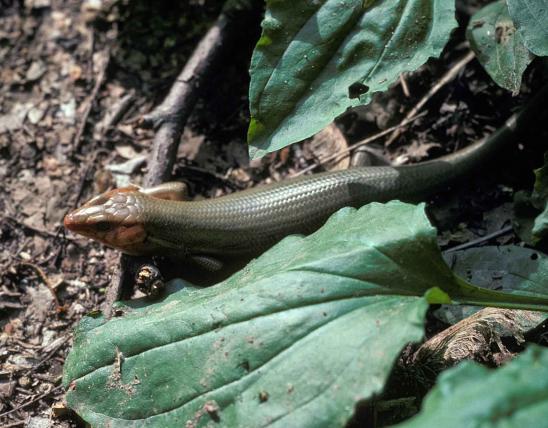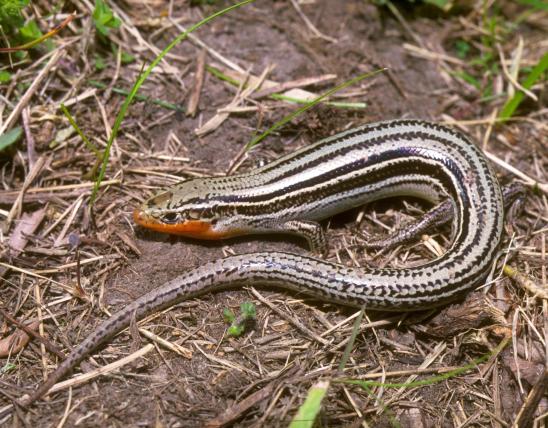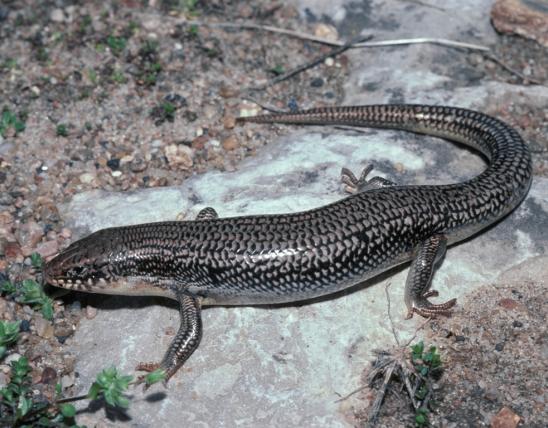
The little brown skink is a ground-dweller with dark brown or black stripes and speckling along the sides. Hiking along a forest trail, you may hear these small lizards scurrying through dead leaves, but you seldom see them. Missouri's smallest species of lizard has a brown or grayish-brown ground color with a wide, dark brown or black stripe down each side on the back, from the snout to the middle of the tail. Usually there are small dark flecks on the back and sides. The belly is light yellow, white, or gray.
Adult total length: 3 to 5¾ inches; adult females are larger than adult males.

Statewide, except for a few counties in the northwestern corner and along the northern border.
Habitat and Conservation
Little brown skinks, formerly called ground skinks, are a woodland species. They seldom venture into open areas unless there is an abundance of natural shelter, such as leaf litter, short grass, or low plant growth with scattered rocks or logs.
On warm, sunny days, little brown skinks can be seen or heard as they dart through leaf litter on the forest floor.
The little brown skink seldom climbs onto rocks, bushes, or trees. On cool days during the active season, this species hides in leaf litter or under flat rocks or logs.
Little brown skinks escape predators by a rapid, lateral, snakelike movement. The tail easily breaks off when grasped by a captor.
Food
Little brown skinks eat a variety of small insects, spiders, and small earthworms.
Status
This species is the most abundant forest-dwelling lizard in the state, and its population is considered secure.
In some locations in Ozark woodlands, this species is the most common of all reptiles.
Life Cycle
Courtship and mating occur in spring or early summer, and females normally produce two clutches a season, with 2–7 eggs per clutch. The eggs are often retained inside the female for a considerable period, and the embryos are already well developed when the eggs are laid. This shortens the incubation period to only about 22 days. Eggs are laid in rotten logs, stumps, or under leaf litter or rocks. Unlike most other skinks, little brown skinks do not stay with the eggs after laying them.
Individuals typically reach sexual maturity within one year, and most individuals live only about three years.
Human Connections
People rarely go out "lizard watching," the way we make special outings just to see birds, but Missouri hikers can really appreciate little brown skinks. They make telltale brief, furtive crunching sounds within dry leaves as they make their getaway. It may seem like a small thing, but our woodsy outings wouldn't be the same without them.
Ecosystem Connections
Because of their small size and ground-dwelling behavior, little brown skinks can fall prey to a variety of predators: snakes, other species of lizards, large wolf spiders, birds, and mammals such as shrews, skunks, and armadillos. Even bluebirds have been recorded feeding these skinks to their nestlings.
This is the only Missouri lizard that has a clear scale on each lower eyelid, enabling it to see when the eyelids are closed. This is an adaptation for its habitat, as it protects the eyes from damage as it darts through thick leaf litter.
The skinks (Scincidae) are a large family of lizards with species on nearly every continent and many oceanic islands. There are over 1,580 species worldwide, representing about 115 genera. The smallest species may be only 3 inches long; the largest (in Australia) may reach a length of over 2 feet. Most species have smooth, overlapping scales and live either on or under the ground. Five genera with about 15 species occur in the United States. A few nonnative species have been introduced into southern Florida. Missouri skinks are represented by two genera with a total of six species and one additional subspecies. All our skinks can quickly break off their tails if grasped by a predator.






























